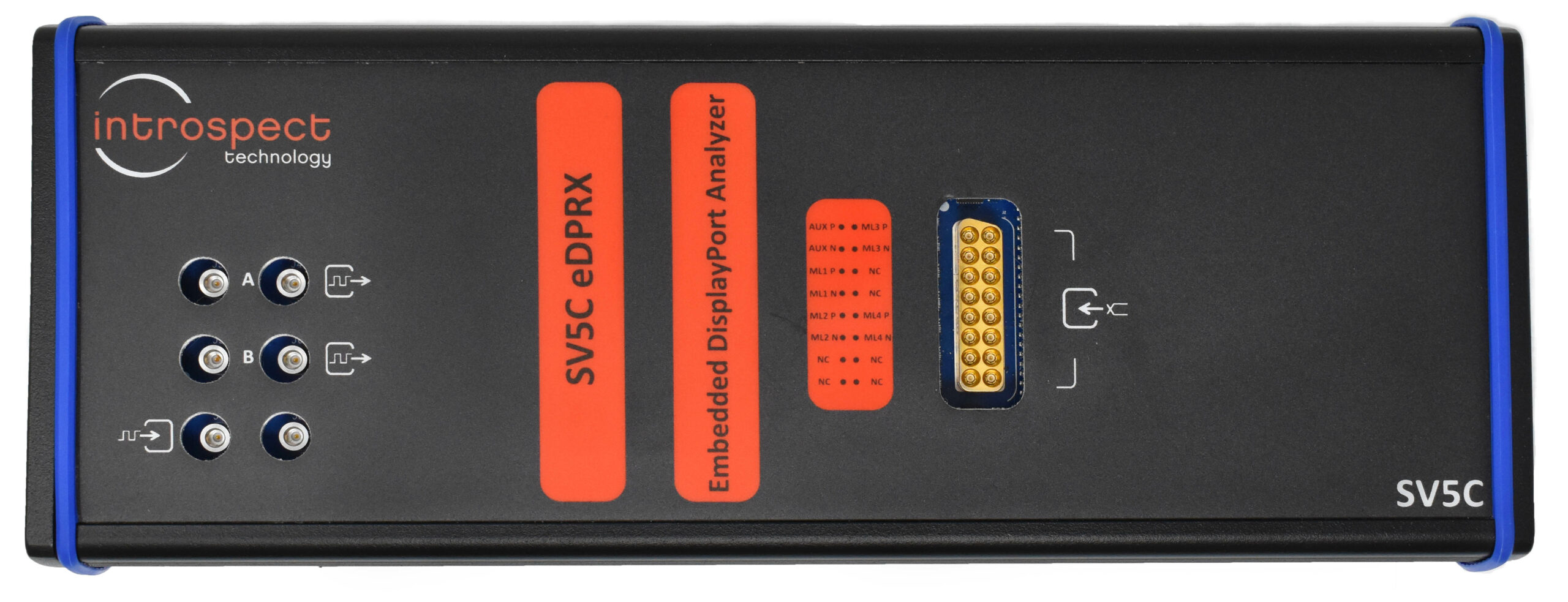
Technical Insights
Testing Panel Self Refresh with the SV5C-eDP Series
6 min

A popular question that is continuously debated in the electronics world is “Which is better: HDMI or DisplayPort?” Well, we’re not here to add to the debate as, most of the time, the answer is dependent on what the person is aiming for in their setup. There are incredibly powerful specs to both HDMI and DisplayPort, and both have pros and cons. In this article however, we will take a closer look at DisplayPort and even more so at Embedded DisplayPort (eDP). Ultimately, we’ll lay out what is involved in testing such exciting protocols and why lately we are so passionate about eDP v1.5.
DisplayPort has been around since 2005. It was developed by VESA to primarily connect video source to display. DisplayPort cables allow you to transfer multiple audio channels and high-definition video from your gaming device to your display of choice. The latest version (2.0) as of 2019, introduced new bit rates and trumps all other standards at a 77.4 Gbps aggregate bandwidth. Additionally, DisplayPort is currently the only solution for 16K and 3D holographic displays.
Sure, bandwidth can be cool, but it’s not what sets DisplayPort apart from other standards. What sets DisplayPort apart are the features surrounding the specification. DisplayPort was quick to publish a specification for “piggybacking” over a USB C (USB-C alt mode adopted in 2014). Plus, the power-saving enhanced version of DisplayPort is now here: Embedded DisplayPort.
eDP v1.5 is displacing low-voltage differential signaling (LVDS) as a promising panel interface in modern laptops and modern smartphones. Key power strategies have been part of the standard for a very long time. Released in 2009, eDP is an extension of the DisplayPort standard for use with embedded displays. The main benefits of eDP over LVDS include the reduction of signal wires due to its higher data rate, compatibility with nanoscale chip processes, decreased interference with wireless services, and its ability to accommodate new features.
The SV5C-eDP Embedded DisplayPort Generator is an ultra-portable, high-performance instrument capable of generating traffic for Embedded DisplayPort and DisplayPort applications at data rates of up to 12.5 Gbps. The SV5C-eDP Generator provides analog parameter controls that enable DisplayPort receiver stress-testing and allow for deep insights into voltage and timing sensitivities of DisplayPort sink devices. In other words, the SV5C-eDP Generator will allow a user to play with their device parameters to evaluate and identify what can make their device lag or break. It can also be viewed as a specification conformity tester and debugger – to allow a user to see whether their device is conformant.
Since Introspect has been testing on DisplayPort specs for some time now, our debugging capabilities only continue to expand to include eDP testing functionality with the SV5C series. With eDP’s focus on power-saving strategies, there are three main protocols that Introspect’s tools can verify: Link Training in Table Mode, Advanced Link Power Management (ALPM), and Panel Self Refresh (PSR).
Link Training is a back and forth communication across the AUX channel in order to find a link configuration that satisfies both the sink and the source.
The parameters involved in link training include:

Figure 1. Parameters involved in link training
ALPM is a power-saving mode which allows turning off the main link during blanking period. It is a handshake between AUX and Main Link. The Main Link issues PHY_SLEEP or PHY_STANDBY before turning itself off. Then, the AUX Channel issues AUX_WAKE to signal to the sink that the Main Link is about to turn back on.
For eDP v1.5, Panel Self Refresh versions 1 and 2 (PSR1 and PSR2, respectively) are advanced protocols for saving power. When PSR is activated, the Remote Frame Buffer (RFB) populates itself with the image data transmitted from the source and continues driving the display panel once the main links go to sleep. This function uses ALPM to conserve power while still displaying images on display panels. Take a closer look for how we test for Panel Self Refresh below.
Simply put, we love debugging eDP because it creates a solid challenge for us, while allowing us to discover how to work with the latest DisplayPort features. As masters of debugging devices and protocol features for our customers, it is only natural for Introspect Technology to constantly adapt to new specs and develop the knowledge and expertise around those specific specs.
Anyone who is familiar with the capabilities of Embedded DisplayPort, knows how extensive eDP’s v1.5 features are. To be able to debug these features then takes another level of mastery and a developed sense of curiosity to implement the debugging functions in a unit such as the SV5C-eDP Generator and Analyzer.
Feeling curious? Send us an email with your inquiries at info@introspect.ca
